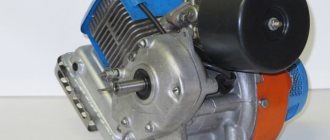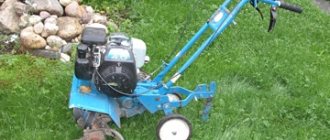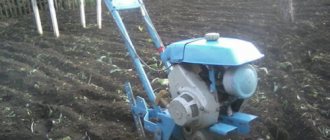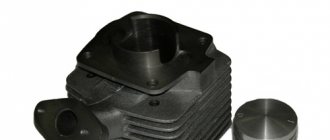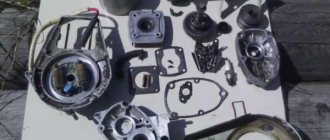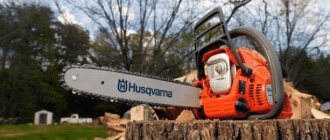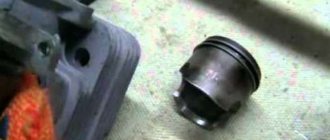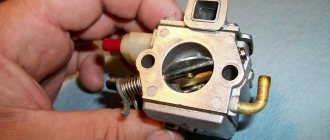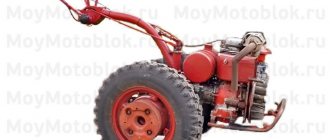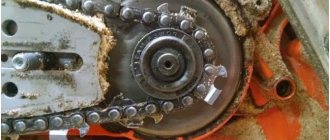Huggies Diapers Elite Soft 8-14 kg (size 4) 66 pcs
1099 ₽ More details
Huggies Diapers Elite Soft 5-9 kg (size 3) 80 pcs
1099 ₽ More details
Fasteners
Among domestically produced small agricultural machinery, the Mole cultivator is quite popular due to its optimal technical characteristics and low cost. However, as every walk-behind tractor owner knows, durability and uninterrupted operation depend on proper maintenance of the equipment. This service includes, among other things, carburetor adjustments required after the end of the season.
Cultivator Mole: technical characteristics and purpose
Gasoline walk-behind tractors "Mole" consist of the following main parts:
- gearbox;
- frame secured to the gearbox with bolts;
- handle for manual control;
- a bracket designed for the use of additional types of equipment;
- levers for switching speed and clutch.
Some modern models are characterized by the presence of reverse gear, switchable on the handle. Mounted equipment is mounted on gear input shafts.
The purposes of the “Mole” cultivator are as follows:
- plowing the soil. Soil cutters are installed on the output gear shafts. The wheels are raised, and a coulter is attached to the bracket, through which braking is carried out and the depth of plowing is adjusted. A pair of external and a pair of internal cutters belong to the category of working bodies and movers of motor-cultivator equipment. On fairly light soils, the additional use of a third set of cutters is allowed, which improves the stability of the equipment;
- weeding activities involve installing special L-shaped weeders on the internal cutters;
- Weeding activities with preliminary hilling of potatoes involve replacing the coulter with a special hiller. The equipment is provided with metal wheels with ground hooks;
- To dig up potatoes, metal wheels and lugs are installed. The opener is replaced by a digger;
- plow plowing involves installing metal wheels and lugs on the gear shafts and attaching the plow;
- If you need to mow grass and make hay, you need to hang the mower on the front of the cultivator. Wheels must be installed on the geared output shafts;
- When pumping water from an open reservoir to the frame, it is necessary to install special pumping equipment. A V-belt drive is used to connect to the engine.
It is very convenient to equip it with a small-sized trolley with a load capacity of up to 200 kg. In this case, replacement with rubber wheels is performed.
Maintenance
What does maintenance mean? This is a series of measures that ensure proper operation and proper storage of equipment. Maintenance of the “Mole” cultivator means the following work:
- washing;
- cleaning;
- lubricant;
- control;
- gas station;
- control;
- fasteners;
- adjustment of all blocks and systems
Such work must be done as often as possible, especially if you have to work in unfavorable conditions.
Before starting the cultivator engine, it is necessary to check the presence of fuel, oil, etc. It is necessary to fill the mixture to a certain level, and if necessary, replace the fuel and oil. For cultivators, Avtol oil (M-8V) is used, which proved itself during the Soviet Union.
If it is difficult to get it, then you can use analogues:
- 10W-30 (do not use at temperatures above +27 degrees);
- SAE 30 (do not use at temperatures below +4 degrees).
Adjustment work involves adjusting the clutch, reverse gear, carburetor, spark, etc.
Cleaning work includes cleaning the filter, working surfaces, housing and all clogged parts on the surface of the Mole motor-cultivator. If malfunctions occur, or for preventive purposes (less often), it is necessary to clean the internal parts of the machine.
Before putting any part back in its original place, make sure it is in good working order.
Installation or replacement of any attachments must be carried out with the engine completely turned off. When preparing for long-term storage, the motor cultivator requires conservation. To do this, you need to prepare the engine in a certain way (see instructions), then clean (rinse) and dry all the external parts of the “Mole”, wipe them with a rag, drying them well. After this, you need to lubricate all accessible areas of the cultivator with grease. The unit is now ready for a long rest.
Operating instructions for the Mole motor cultivator
The instruction manual supplied with the unit allows you not only to use the motor cultivator correctly, but also to perform simple repairs yourself. The average service life can be significantly increased with strict adherence to all rules for operation, maintenance and storage.
The basic operating rules specified in the instructions are as follows:
- the first fifteen hours of operation are considered the running-in time of the device, therefore it is unacceptable to use the unit at full capacity;
- process the area in several passes, with a gradual increase in depth;
- it should be remembered that the space located between the rotor blades and the gear housing can become clogged with foreign objects, which requires monitoring and timely cleaning;
- When cultivating soil with a significant amount of plant debris and stones, it is recommended to carry out work at a reduced speed of rotation of the rotor blades.
The motor cultivator can be transported in the luggage compartment of a car by laying the unit on its side with the starter turned upward, which will prevent oil from draining from the gearbox.
Filling the fuel tank, as well as adjusting the carburetor and activities related to maintenance must be carried out with the engine stopped. It is also necessary to strictly adhere to general fire safety rules when performing work with any flammable liquids.
It is very important to minimize the risk of fuel mixture coming into contact with a hot engine or muffler, and the engine is started with the clutch disengaged. The Krot cultivator is operated with installed covers.
DIY repair
If the device fails, first of all, you should check the warranty period and, if it has not yet expired, contact a service center. In some cases, the device requires qualified repair or even replacement. However, troubleshooting is often possible with your own hands. However, as mentioned above, it is best to prevent malfunctions from occurring through proper maintenance of the device.
During operation, it is important to monitor its condition and, if necessary, clean and replace worn parts. By the way, they are the ones that can cause the engine to seize. Difficulties may also arise with closing the carburetor damper - this problem can be eliminated by monitoring the operation of the drive. Do not forget about the quality of the fuel used, which must necessarily meet the manufacturer’s requirements specified in the operating instructions.
Tags: hole, located, pipe, then, channel, stroke, help, level, a little, through, sides, tube, stud, body, cover, power, works, similar, insert, make, system, remove, pretty, k60v, most, many, position, coincided, therefore, since, special, factory, valve, or, while, do, heat, Soviet, large, country, pull out, soil, soil, unscrew, leads, several, needle, beds, correctly, workers
Installing an imported engine on a Mole walk-behind tractor
It is generally accepted that the operation of such a model with an imported engine becomes more stable and convenient for the operator. In this case, minimal modifications to the frame will be required, and the whole process will consist of several fairly simple manipulations. Many owners of the Krot cultivator note that the best option is to install it on a Lifan-168FB engine with a power of 6.5 l/s. Patriot and SadkoDE-220 with a power of 4.2 l/s for installation
Do-it-yourself engine replacement algorithm:
- unscrew all fastenings on the factory engine, represented by four standard bolts;
- remove the muffler and gas wires and remove the factory engine from the frame;
- Mark all the drilling points on the frame, which will allow you to install the new engine. To do this, you need to install the new engine on the frame, put on a belt and move the motor along the frame to the required belt tension;
- mark areas for drilling a pair of through holes and drill them;
- secure the new engine to the frame using bolts 3.5 cm long;
- tighten a couple of bolts until they stop, then connect the system to the clutch, gas and muffling.
After the new engine is installed on the walk-behind tractor frame, you need to once again carefully inspect all connection points and test the operation of the unit.
How to replace the engine on a Mole cultivator (video)
We eliminate engine breakdowns
If the cultivator engine does not start:
- blow out with air or disassemble and clean the fuel supply system;
- clean or completely replace the filter;
- remove the blockage in the drain hole of the cap on the gas tank;
- Replace spark plugs or magneto.
If the engine stalls or runs rough:
- remove carbon deposits from spark plugs;
- tightly install the tip of the high-voltage wire onto the spark plug.
How to replace bearings on a Mole cultivator (video)
The Mole model, a popular motor-cultivator in our country, is intended for use in regions characterized by moderate climatic conditions. The air temperature during operation can vary between 1-40°C, and the service life of the unit directly depends on strict adherence to all operating rules, proper maintenance and proper storage.
The Mole walk-behind tractor is a small-scale mechanization tool designed directly for working with the ground. Its great popularity in our country is due to the fact that, despite its low cost, it shows quite good technical characteristics.
However, in order for this walk-behind tractor to continue to work correctly, it must be periodically maintained.
These measures can significantly extend the operational life of the unit, without losing its performance qualities.
One type of such maintenance is carburetor adjustment , which must be carried out immediately after the end of the first season of operation.
Device
The Mole walk-behind tractor is a fairly standard design without the use of frills. This model of walk-behind tractor began to be produced in 1983 in Moscow, but then the production of this unit expanded, so they began to be produced in Omsk.
They were equipped with factory engines, the power of which did not exceed 2.6 hp. It is attached, like the gearbox, to the frame using ordinary bolts. The declared power was not always enough, so many Mole owners adapted to some modifications, replacing the factory engine with more powerful models.
In general, the structure of the Mole walk-behind tractor looks like this:
- Frame structure on which the internal combustion engine and gearbox are located.
- The control handles on which the clutch is located, as well as the engine speed controller.
- A wheelbase that allows you to freely move the unit from place to place. During operation, these transport wheels are removed.
- Soil cutters, which are put on the output shafts of the gearbox.
For more details about the Mole walk-behind tractor, watch the video:
As we can see, the design is very simple, which allows you to carry out repair work yourself. But you may have to do this, because the factory engine does not always operate in a stable mode.
The operating principle of the Mole walk-behind tractor is as follows. The torque is transmitted to the gearbox, and then to its two output shafts through a V-belt. When the clutch is pressed, the belt is tensioned, driving the gearbox shaft.
This gearbox shaft, on which the cutting elements (soil cutters) are located, rotates around its axis, cutting off the soil crust, while at the same time crushing and mixing it. Similar translational movements are used to move the walk-behind tractor along the surface of the earth.
The kit includes four rototillers , which need to be placed in pairs on each side of the shaft. By the way, it is possible to install six cutting elements at once, which improves the quality of tillage.
The scope of application of this and other walk-behind tractors, such as Cayman, Patriot, Texas, Foreman, Crosser, Viking, Forza, can be significantly expanded if additional attachments are attached to it. It is connected to the unit through a special bracket located at the back of the walk-behind tractor.
You will have to purchase such equipment separately, but thanks to it, an expanded scope of work opens up:
- transportation of goods of various weights;
- processing of inter-row spaces of beds;
- hilling and weeding of beds;
- making hay for livestock;
- planting and digging up potato tubers;
- using the pump you can water the beds, etc.
In other words, with the help of the Mole, Sadko, Don, Huter, Profi, Plowman, and Champion walk-behind tractors, you can carry out virtually the entire range of agricultural work. This circumstance makes it an indispensable assistant for a rural resident who uses his garden to the fullest.
Description
The walking tractor "Mole" appeared in the early 80s of the last century and immediately gained popularity among rural residents and dacha owners. This is not surprising, because with the help of this agricultural technology it became possible to mechanize soil cultivation, as well as planting, caring for and harvesting crops.
Over more than 30 years of its existence, “Mole” has been modified more than once. Its parts such as the engine, gearbox, handles, cutters and other equipment (including accessories) have been improved. Having gone through a difficult path of improvements, we no longer received the original walk-behind tractor, which has some limitations in operation, but a multifunctional motorized device with which you can easily perform the following field work:
- plowing the soil;
- open the beds;
- planting potatoes;
- climbing plants;
- weeding;
- mechanized potato harvesting;
- mowing;
- irrigation;
- transportation of bulk and consolidated cargo;
- snow blower.
To perform all of the above work, you need to purchase the appropriate tools. Read more in the article about the accessories of the Mole walk-behind tractor on our website.
No matter how powerful your unit is, no matter how much you worry, sometimes it still requires repair: the engine does not start, the engine warms up, or some other malfunction... To know how to repair a cultivator, you need to understand its structure.
How to adjust - setting and adjustment rules
Many people wonder how to adjust the carburetor installed on a Mole walk-behind tractor? Many people note that it is this particular working unit that causes the most problems. The thing is that the Mole is also equipped with a Soviet K60-B carburetor, which is used in the design of mopeds.
Before describing the likely problems with it, you need to consider how to adjust this carburetor, which will help avoid these very problems. So, our actions will be as follows:
- To adjust the carburetor fuel level, we need to remove the float chamber of the Mole walk-behind tractor.
- After this, turn the carburetor over so that the float is at the top. Then we bend the tongue until the distance H is exactly about 15-17 mm.
- This carburetor has two adjusting screws. One regulates the throttle lift, and the second controls the quality of the mixture used. The design is made in such a way that when the second adjusting screw is tightened, the mixture is enriched and vice versa.
- First, you need to warm up the engine a little, and then start adjusting the idle speed. By the way, at the initial stage you need to adjust the ignition.
- We adjust the position of the screw responsible for the quality of the mixture. To do this, you need to screw it 1 or 1.5 turns counterclockwise until it stops.
- At this time, we use the throttle screw to normalize the stable operation of the engine. Then we use the quality screw to increase the number of revolutions.
If everything is done correctly, the engine will respond normally to the opening of the gas , without the appearance of failures. In addition, the rotation speed will remain unchanged, regardless of the degree of warming up.
How to adjust the carburetor?
The adjustment of a particular carburetor depends on the specific model of the walk-behind tractor. In order to successfully adjust the carburetor on a walk-behind tractor, you must follow the operating instructions from the manufacturer. Otherwise, you should be very careful when setting up, because the situation can only worsen. In order not to harm the “breadwinner of the family,” you can also turn to specialists. They will definitely do everything right. Let's look at the sequence of steps for adjusting a Cascade carburetor:
- We start the engine and adjust it only when the power unit is warm.
- Screw in the low and high throttle screws until they stop.
- We unscrew the same screws 1.5 turns.
- Next, we switch the walk-behind tractor to minimum speed, and the engine continues to operate.
- If everything is done correctly, the engine runs stably without interruptions.
Such measures are usually carried out before each start (at the end) of the season. How do you know if everything is done correctly? – after long-term operation of the walk-behind tractor, pay attention to the spark plug. It should not be filled with fuel. There should also be no soot.
We hope that this article will be extremely useful to you. Technology requires attention, remember this. Moreover, every gardener should know the structure of a walk-behind tractor carburetor!
Video
Repairing the carburetor of the Mole walk-behind tractor
The carburetor of the Mole walk-behind tractor was produced back in Soviet times . Despite the fact that the Soviet industry was famous for its high level of performance and reliability, this carburetor still had several flaws. To understand them, you first need to completely analyze it into its components:
- Remove the cover by unscrewing the bolt on it. Underneath we find a gasket made of gas-resistant material, as well as a spring that needs to be pulled out.
- We take out the damper located there, under the cover.
- On the reverse side there is a float chamber, which also needs to be unscrewed. We remove the gasket.
- Then you need to remove the float by removing the pin from the corresponding hole. There is a special needle under the float, which also needs to be removed. On it we find a small elastic band, which under no circumstances should be lost, so we carry out all manipulations very carefully.
- We unscrew the fitting under which the gasoline filter is located.
- Then you need to remove the jet. After this, we need to pull out absolutely all the “internals” located in the carburetor body.
Such disassembly is necessary , because we gain access to the internal content, which is considered the most problematic.
The most common defect of such carburetors is the adjusting screw, which is responsible for the quality of the mixture.
In other words, we turn this screw, but the mixture does not change, it remains constantly the same.
To change this, you need to make some repairs to the carburetor located inside the Mole walk-behind tractor. The main cause of problems with mixture adjustment is one circumstance. The fact is that inside the carburetor there is a special channel that runs to a tube located in the center of the carburetor.
The T-70S tractor is a multifunctional unit for a wide range of activities. By clicking on the link, you will become familiar with the advantages and operating features of the T-70 tractor.
A bulldozer is a tracked or wheeled earth-moving machine that belongs to the class of special equipment. Monster bulldozers are the largest in the world of special-purpose vehicles.
The market of our country offers products from a large number of world-famous manufacturers of snow removal equipment. It's all about the legendary German snow blower Huter.
In this pipe, in theory, there should be a through hole connecting this very channel. The problem is that on some factory units this pipe is installed askew, which leads to the fact that the channel and the hole on the pipe do not match.
There are cases when this hole is completely absent on the pipe, or it is of insufficient diameter. To carry out repairs, we need to perform several sequential steps:
- Unscrew both adjusting screws. Please note that the screws have different tapers - the mixture quality screw has a larger taper.
- To pull out the pipe located inside, we need to slightly heat the part that is located outside. To do this, you can use a small fire on a gas stove, or heat it with a regular lighter.
- We warm until he can hold the body in his hands. After this, we insert the pin into the hole where the cover fastening bolt was located.
- Using a hammer, carefully hit the inserted pin until the pipe pops out.
- As practice shows, the hole is drilled only on one side of the pipe, i.e. it is not end-to-end. We need to make a symmetrical hole on the other side of this tube, or modify the one that exists.
- If there is a second hole, but it is smaller in diameter than the first, then we need to sharpen it a little. To do this, we use a regular round needle file and bore the edges of the hole.
- Then we install the tube in its original place. This must be done in such a way that the through hole on it and the hole on the channel coincide exactly.
- Before inserting the tube into place, you need to slightly heat the carburetor body again so that it fits into place without problems.
- We insert the tube into place and, using the same pin that we used to push the pipe out, we insert it into place. We knock lightly so that the pipe does not go far inside - on the back side we should see a hole located just above the through hole, which should coincide with the channel.
- You need to make sure that the hole is strictly in the center.
- We take a thick wire and insert it into the channel hole. If everything is done correctly, then the wire should freely pass further through the through hole on the pipe and come out of it as a continuation of the carburetor channel.
- If the wire gets stuck, then you need to tap the pin a little more, pushing the pipe a little further.
- Next you need to reassemble the carburetor in reverse order.
Common breakdowns
Which parts of the machine may require the most attention from the operator?
Let's list them:
- engine;
- magnet, ignition system;
- carburetor;
- adapter;
- air filter, etc.
Now let's take a closer look at all the malfunctions that can affect the performance of the unit, regardless of what model it belongs to.
Does not start
So, what to do if the “mole” does not start, what could be the reasons. Debris or no fire in the following cases:
- There is no spark. This could mean that the spark plug has burnt out. In this case, you need to unscrew it and simply replace it with a new one that works.
- The candle is smoking. A good cleaning (removing carbon deposits, cleaning the contact) will bring it back to life, after which the spark plug must be thoroughly rinsed in gasoline.
- If the grower does not start, but there is a spark, then most likely the reason is the lack of insulation. Look at the candle again, in this case it is wet or a little damp. There is no need to change the entire plug, just replace the tip.
- Poor fuel quality may be the reason why the cultivator does not work. It is for this reason that the spark gets wet, after which the tip will have to be changed.
- Fuel leaking from the spark plug is another reason why your car won't start. To correct the situation, it is necessary to empty the cylinder by pumping the engine with a winder.
- The reason for the lack of ignition may also be a problem with the fuel lines. To restore the operation of the cultivator, it is necessary to either tighten the pipes well, or, in case of breakdown, replace them with new ones.
- Poor electrical insulation (high and low voltage cables) can also prevent the device from starting.
- Pay attention to the air filter. If it is dirty, then problems with ignition are expected. It needs to be cleaned or replaced. Very often they resort to the second option, since this spare part is both affordable and available in the store.
- Failure of the magnet itself. This part cannot be repaired; it is immediately replaced with a new one. How to check the magnet of the Mole walk-behind tractor to make sure that it is faulty? Everything is very simple: if you exclude all the reasons why there may be no spark, then the cause of the malfunction is precisely the magnet. Many craftsmen remake the working magnet, thereby increasing its resource.
This is what the Magneto ignition circuit for the “Mole” motor cultivator might look like
- There may be no ignition if the flywheel plates jam the magnetic circuits.
- An incorrectly set gap between the electrodes will prevent a spark from passing through.
Video review of the modernization of the ignition of the “Mole” motor cultivator
As you can see, setting up the ignition is not that difficult.
Engine
The main reasons why the Krot engine does not start:
- lack of fuel (or its low quality);
- ignition problems discussed above;
- the appearance of decompression and, as a consequence, piston wear and deformation of the exhaust valve.
In the first case, it is enough to fill in the required amount of fuel (a mixture of gasoline and oil from an M-8V auto scrap car) and all problems will be solved. In case of compression failure, you will have to completely disassemble the engine and replace damaged parts, and this could be a piston or an o-ring.
Deformation of the exhaust valve becomes another cause of compression failure, which first leads to a loss of power of the Krot cultivator, and then to problems with starting.
To restore engine functionality, it must be completely disassembled. Having assessed the condition of the piston, replace it if necessary. We change the piston rings and exhaust valve. We examine the cylinder head, especially the gas distribution mechanism, for the presence of carbon deposits, and clean it. If structural elements are damaged, we replace them with repairable ones.
Motor selection
In the Soviet Union, only domestically produced two-stroke single-piston engines were used, which were not particularly powerful. Today you can find “Mole” with an imported four-stroke engine. But if you still have the first model of cultivator in your arsenal, upgrading your “mole” by replacing the motor will not be difficult.
And here a new question arises - which motor is better to install on the unit? The answer is easy - those models that are installed on newer machines are suitable.
It is better to replace the domestic engine with an imported one:
Each of them will not only give the walking tractor a new life, but will also significantly increase the power and resources of the unit.
An excellent solution would be to install a Lifan motor on a Mole cultivator. Such an engine provides the car with a long life, because in addition to reliability and efficiency, Lifans are unpretentious and certainly do not require additional attention.
Video review of replacing the engine on a Lifan 168 F-2 with a Mole cultivator
Carburetor
What is a carburetor and why should you tune it? A carburetor is a small device designed to produce an air-fuel mixture. This mixture, with the help of a piston and a spark plug, will be maximally compressed and ignited, the engine will start and continue to work.
Carburetor adjustments should be made after the first season of operation.
Carburetor adjustment is one of the mandatory items included in the “maintenance” section of the unit. Due to timely inspections and repairs, the life of the grower will increase. In addition, inspection and adjustment are also required when the engine rattles excessively for no apparent reason.
Before you start making adjustments, you need to familiarize yourself with the design of the carburetor of the “Mole” cultivator:
So, in order to adjust the fuel supply and ensure the desired speed, you need to use two screws - the number of revolutions (in the figure) and the quality of the fuel (figure). Using these two screws, we regulate the fuel supply to the carburetor of the Mole walk-behind tractor at idle. You need to act very carefully, first check the ignition condition.
Important! If necessary, thoroughly clean the carburetor - clean it, rinse if necessary - replace parts. Then the mole guide will serve you for a long time.
Car owners are often interested in how to start the Mole cultivator after winter. The reason for the lack of ignition is condensation in the carburetor that has accumulated during downtime at various temperatures. Complete disassembly of the device and further cleaning will help solve this problem. All kinds of additives present in low-quality fuel and dust seeping through the filter will not contribute to the operation of the device.
Gearbox
The main task of the gearbox is to transmit torque from the motor to the shaft. The transmission of motion occurs through a V-belt transmission. You can learn more about the design and repair of the Krot walk-behind tractor gearbox by watching the video.
Video review of the Mole motor-cultivator gearbox
Reverse
The first modifications of the "Mole" are not equipped with a reverse function (reverse), which somewhat affected their performance characteristics and ease of use with accessories such as a cart, snow blower, mower, and so on. The “Mole” manufacturer has released new modifications, already with a reverse function, which significantly increased the mobility of the cultivator.
Video review of the reverse function on the Mole motor-cultivator
Drive belt
The drive belt transmits torque from the engine to the gearbox. Failure of the Mole walk-behind tractor is often due to a broken drive belt. This is due to the belt jamming during operation due to heavy loads on the working parts of the cultivator (hard soils, blunt cutters). The cutter folds and catches the belt with the knife, making it unusable.
The drive belts of the Krot cultivator can have various modifications, but their dimensions are strictly defined:
